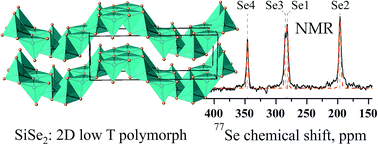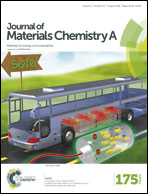Synthesis, crystal structure, and advanced NMR characterization of a low temperature polymorph of SiSe2†
Abstract
A low temperature polymorphic modification of silicon diselenide was synthesized via solid-state reaction and its crystal structure was determined by single crystal X-ray diffraction. In contrast to the well-characterized high-temperature form of SiSe2, where edge-sharing SiSe4 tetrahedra form one-dimensional chains, in the crystal structure of the low-temperature polymorph two-dimensional puckered layers are formed via edge- and corner-sharing SiSe4 tetrahedra. Such rearrangements have a significant impact on the electronic structure of SiSe2 as revealed by quantum chemical calculations and optical spectroscopy. The experimentally determined indirect bandgap for the low-temperature modification of SiSe2 is 2.00(5) eV. Multinuclear (77Se, 29Si) NMR spectroscopy combined with first principles calculations is applied to characterize the NMR chemical shift tensor parameters for the Si and Se sites in the crystal structure. These results will enable quantitative application of combined 29Si and 77Se NMR spectroscopy in future structural studies of Si–Se glasses, whose structures consist of both corner- and edge-sharing SiSe4/2 tetrahedra.


 Please wait while we load your content...
Please wait while we load your content...